An area where I see a lot of missed opportunity for account optimization is in Facebook remarketing audiences. Soooo many accounts are set up with a single audience for the past 30 days of visitors, and that’s it. It’s easy to just do that and forget it because the return on remarketing can be so high it hardly seems worth fussing with. It can also just be that if the traffic numbers are small, splitting it into multiple lengths of time doesn’t make sense.
But that 30 day set up just sits there, running and collecting dust.
However, for instances where you’re creating a fairly big remarketing pool, it’s worth looking a little closer and strategizing a little harder. Let’s talk about some ways to do that!

Remarketing Time Buckets
In the instances where I see the ol’ 30 day audience, I will sometimes see an attempt with buckets for 7 days as well. This may or may not make sense for how a site’s audience typically behaves.
My #1 recommendation for sites with healthy traffic and sales data is to see what buckets make sense according to what your audience’s buying habits actually are. A good place to look at this is in the Time Lag report in Analytics.
You can find this by going to the “Conversions” section in Analytics, and then choosing the drop-down for Multi-Channel Funnels:
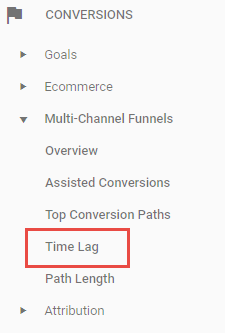
And there’s Time Lag!
Interpreting Time Lag For Remarketing Strategy
When you choose it, you get a handy view of the percentage of total conversions that occurred since the user had their first interaction. Of note is that you can choose which conversions you actually want to see – this is helpful if you have multiple events, for example Purchases and then Opt-Ins for a List.
This report actually gives you some really rich data, especially if you’re running Ads for those different kinds of Events. For example, here’s the Time Lag on an Opt-In:
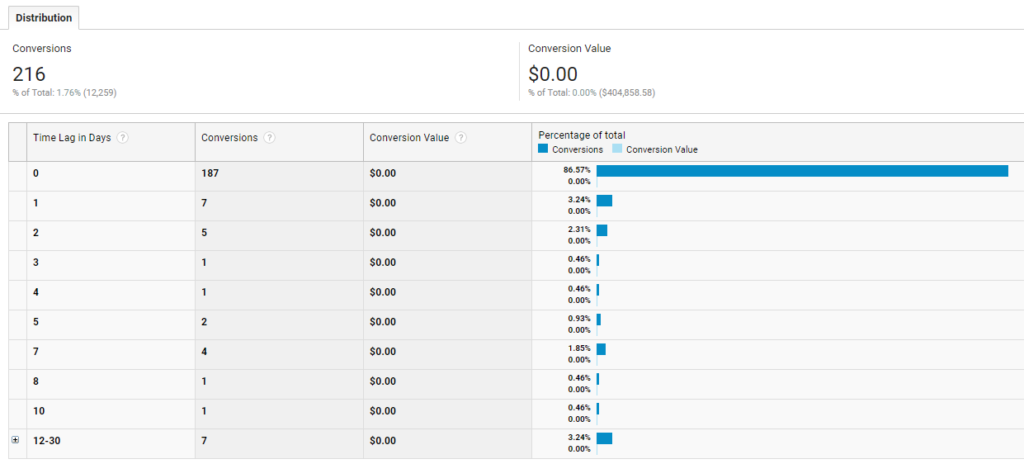
Note how almost all of their Opt-Ins for this month so far occur in their first visit. This means that running remarketing with the goal of driving opt-ins for 30 days doesn’t make sense. It’s a waste of money for all the extra impressions the extra days will cost you.
By comparison, here’s their report for Purchases:
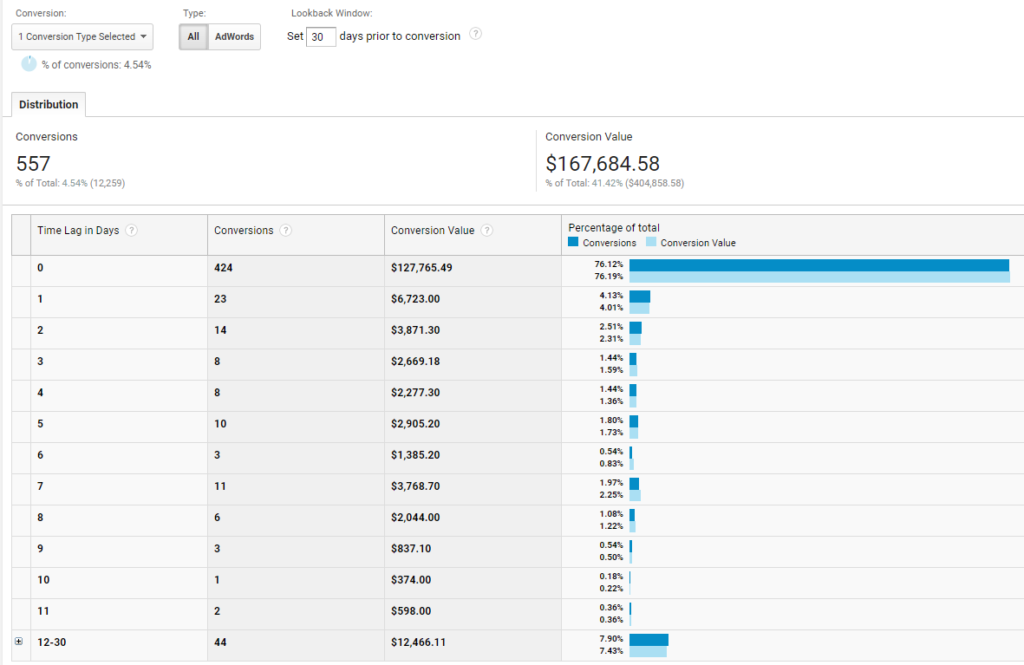
While that fist visit still generates the bulk of their conversions, they do have some decent revenue that continues to come in for a few days.
Based on their Time Lag report over a several month period, I restructured their old remarketing setup (which was just set to 30 days) to be buckets of 3 days, 7 days, and then 14-30. Important note: I excluded the group from the next tier up, so the 7 day targeted excluded the 3 day visitors, ensuring everyone got the correct messaging. Doing it this way also allowed us to control where the budget went, as well.
Look how their CPA dropped like a rock – we started making changes on 7/7. (Note: there was a sale leading up to the 4th of July holiday, which skewed the data to that super-low $85.64 CPA…you’ll see how it went back up after that).
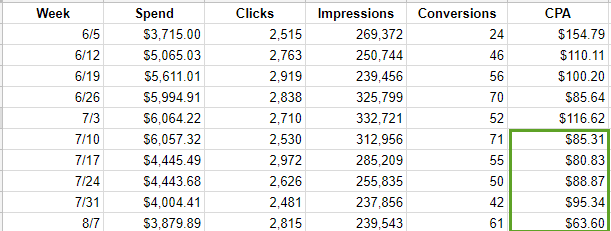
The creative and offers stayed the same – this was due to restructuring things and switching to a Link Click-focus. (More on this in the “Cost Consideration” section below.)
The bonus to this is the number of conversions per day also went up even though we ere spending substantially less during this time period. Throwing away the week of 6/26 since the sale skews things, they were averaging 42 purchases a day. Post-restructure, they are averaging 55.
Urgency To Retain Interest
Something else that can work well with these buckets is capitalizing on deal urgency. In many cases, the further the user gets away from their initial visit, the more you see purchases drop.
Interest fades.
You can combat this by doing some math on what you can afford to give in order to get – how much wiggle room do you have to discount in order to close the sale?
If you know your real last shot to close them is the 14-21 day mark, maybe just for that group you run a 10% discount with “last chance” messaging. Think through your funnel and where users are in it to try and maximize converting them.
Free Trial Expiration & Upgrades
Another handy way to close a sale is to get back in front of your audience if there’s any other deadline that exists in your sales funnel.
Say you offer a free 30-day trial to users, and then they have to upgrade in order to continue using. Set up a remarketing reminder to trigger a few days before the trial expires reminding them that they are about to lose access.
Or, maybe you offer an upgrade or an add-on to your sale. So many times I see accounts remarket for the sale, and then rely on emails or some other channel to do the heavy lifting for upgrades. That “Purchased” audience just acts as an exclusion and totally goes to waste otherwise!
Create buckets of users who Purchased, and market your upgrades to them to maximize your ROAS per user!
Keep Your Audiences Clean
FOR. THE. LOVE. Please exclude users who purchased from your acquisition funnels. There’s nothing more annoying than continually seeing ads for something you already bought.
ALSO, and this is a HUGE one that I see NOT done constantly: exclude previous visitors from your acquisition campaigns, NOT just purchasers.
Why?
Because you want to funnel them ONLY to your awesomely-crafted remarketing strategy.
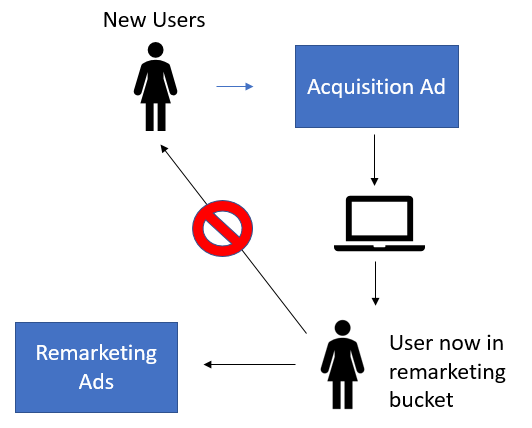
I see too many instances where managers don’t exclude visitors, so they wind up co-existing in the acquisition AND remarketing funnels.
This can also really skew the data on the return for your Acquisition efforts, because it’s counting someone who is actually part of your warm audience already.
Saving Some Cheddah!
One more thing I want to touch on: cost.
Remember that in Facebook, you pay for ads on a CPM basis, always. As you ask for more targeted/specified needs, your CPM gets higher. This usually works out to mean that Conversion campaign types carry the highest CPM, but will work in your favor with a higher conversion rate.
More and more, I run remarketing campaigns to switch to optimize to link clicks. (You can still run it as a Conversion campaign and do this if you want to toggle the setting back and forth to test.) If you have a pretty hot audience on your hands and it’s tightly focused (say, 50,000 size or less) you generally don’t need to pay the high CPMs on conversion-focused. The audience is already primed and ready to go, you’re just trying to drive that last click to convert.
By switching to a link click-focus, you pay a lot less to reach those people. Conversion-focused is good for larger data sets when there’s a lot of data for Facebook to go off, but it can struggle with smaller sets – so in the case of remarketing, you’d be paying more for a subset of traffic that may not even convert efficiently enough to justify that higher CPM.
Also, pay really close attention to your frequency on remarketing. Facebook wants to earn their CPM and will show your ads the thousands of times they need to, even if it’s a teensy audience! They are especially bad about this in the right-hand column placements, so watch out.

Great article! I love the section which breaks down the audiences into different remarketing buckets based on the conversion time-lag. I do something similar with display remarketing campaigns and I’ve found it works especially well once we introduce some new creatives & messaging at the different stages
Thanks for the share Susan!
Which one of these ways wiped the MOST dust off facebook remarketing?